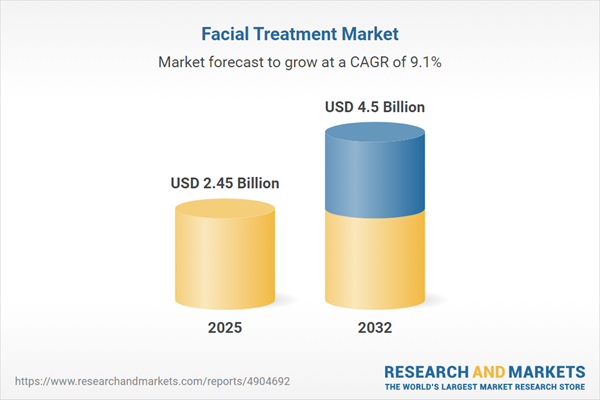Speak directly to the analyst to clarify any post sales queries you may have.
The facial treatment market is undergoing accelerated transformation, shaped by digital innovation, evolving consumer priorities, and a dynamic regulatory environment. Senior decision-makers navigating this sector must prioritize agility and strategic foresight for sustained organizational growth.
Market Snapshot: Facial Treatment Market Growth and Trajectory
In 2024, the facial treatment market is valued at USD 2.25 billion, with forecasted expansion to USD 2.45 billion in 2025 and USD 4.50 billion by 2032, reflecting a 9.07% compound annual growth rate (CAGR). Key factors propelling growth include surging demand for personalized skincare, greater adoption of wellness routines across consumer segments, and increasing reliance on digital platforms by industry leaders. Rising global competition and complex compliance demands are reshaping go-to-market strategies and business models. Senior stakeholders increasingly rely on collaborative B2B partnerships and operational flexibility to protect market share and drive innovation.
Scope & Segmentation
- End User Demographics: The market addresses women, men, and unisex segments, allowing brands to create inclusive skincare offerings and embed diversity initiatives into their portfolios for broader appeal and partnership building.
- Distribution Channels: Operations extend across department stores, specialty retailers, pharmacies, and e-commerce platforms, enabling brands to leverage omnichannel strategies and optimize engagement throughout the customer journey.
- Skin Concerns Addressed: Core solutions are targeted at resolving acne, sensitivity, anti-aging effects, dry skin, and pigmentation, positioning partners to meet a wide range of client needs and enhance market differentiation.
- Product Types: Available options range from anti-aging formulations and skin brighteners to cleansers, exfoliants, and moisturizers, supporting partners in creating tailored product programs for specific and diverse audience requirements.
- Treatment Modes: Service models now include in-clinic treatments, device-driven at-home applications, and offerings within spas or salons, giving stakeholders the flexibility to implement multichannel strategies reflecting shifting consumer preferences.
- Regions Covered: The operating landscape spans the Americas, Europe, Middle East and Africa, and Asia-Pacific, each characterized by diverse regulatory requirements, consumer attitudes, and business environments requiring targeted market entry and adaptation.
- Leading Companies: Influential organizations driving category leadership include L’Oreal S.A., Unilever PLC, The Procter & Gamble Company, Estée Lauder Companies Inc., Johnson & Johnson, Shiseido Company Limited, Beiersdorf Aktiengesellschaft, Amorepacific Corporation, Kao Corporation, and Moët Hennessy Louis Vuitton SE.
- Technological Innovations: Industry players deploy AI diagnostics, targeted ingredient technologies, mobile-enabled tools, clean-label advancements, advanced personalization, augmented reality experiences, and robust omnichannel platforms for sustained customer engagement and operational improvement.
Key Takeaways for Decision-Makers
- Leveraging a blend of clinical, home-use, and hybrid service models broadens client reach and enhances engagement while supporting personalized experiences.
- Deploying digital tools, such as virtual consultations and insights dashboards, enables agile monitoring of market activity, supporting real-time strategic adjustments across B2B and B2C segments.
- Pursuing sustainable sourcing and packaging initiatives ensures compliance with evolving industry responsibility standards and future-proofs operations against regulatory changes.
- Adapting products and resource allocation to meet localized market needs accelerates responsiveness and strengthens regulatory alignment in diverse regions.
- Integrating predictive analytics and data infrastructure streamlines logistics, supports adaptive supply chain planning, and optimizes product recommendations for enhanced user satisfaction.
Tariff Impact: Navigating Trade Policy and Supply Chain Transformation
Anticipated changes in U.S. tariffs prompt organizations to reexamine supply chain configurations, prioritize proximity manufacturing, and build strategic supplier alliances. The adoption of modular production methods reduces disruption risks and maintains consistent quality and compliance in a shifting trade environment.
Methodology & Data Sources
The insights in this report are built from executive interviews, comprehensive consumer survey data, and systematic regulatory reviews. Data-driven techniques and sentiment analysis validate findings and offer a real-time understanding of the facial treatment market's changing dynamics.
Why This Report Matters
- Empowers executives to enact digital transformation and boost operational resilience in the facial treatment market, adapting proactively to industry change.
- Supports forward-focused planning by delivering insights on regulatory compliance and optimizing supply chain risk strategies.
- Presents a unified perspective that connects technology use, business model innovation, and required regional differentiation to competitive advantage.
Conclusion
Long-term success in facial treatments hinges on flexible, proactive adaptation to regulatory, technological, and consumer dynamics. This report equips decision-makers with the foresight and clarity required for confident, responsive leadership.
Additional Product Information:
- Purchase of this report includes 1 year online access with quarterly updates.
- This report can be updated on request. Please contact our Customer Experience team using the Ask a Question widget on our website.
Table of Contents
3. Executive Summary
4. Market Overview
7. Cumulative Impact of Artificial Intelligence 2025
Companies Mentioned
The companies profiled in this Facial Treatment market report include:- L'Oreal S.A.
- Unilever PLC
- The Procter & Gamble Company
- Estée Lauder Companies Inc.
- Johnson & Johnson
- Shiseido Company, Limited
- Beiersdorf Aktiengesellschaft
- Amorepacific Corporation
- Kao Corporation
- Moët Hennessy Louis Vuitton SE
Table Information
| Report Attribute | Details |
|---|---|
| No. of Pages | 183 |
| Published | October 2025 |
| Forecast Period | 2025 - 2032 |
| Estimated Market Value ( USD | $ 2.45 Billion |
| Forecasted Market Value ( USD | $ 4.5 Billion |
| Compound Annual Growth Rate | 9.0% |
| Regions Covered | Global |
| No. of Companies Mentioned | 11 |









